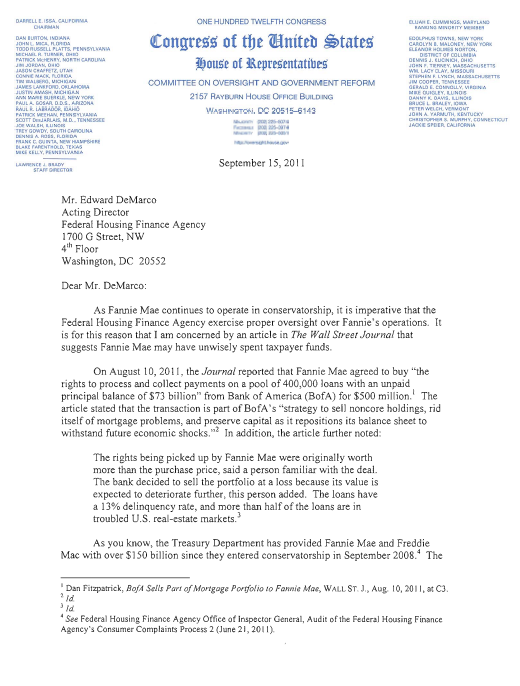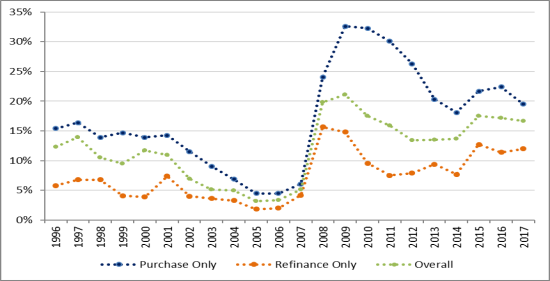The Financial Crisis Inquiry Commission found that in 2008, GSE loans had a delinquency rate of 6. 2 percent, due to their traditional underwriting and certification requirements, compared to 28. 3 percent for non-GSE or personal label loans, which do not have these requirements. Additionally, it is unlikely that the GSEs' long-standing inexpensive real estate objectives motivated loan providers to increase subprime lending.
The goals stemmed in the Housing and Community Development Act of 1992, which passed with overwhelming bipartisan assistance. Despite the fairly broad required of the affordable real estate goals, there is little evidence that directing credit toward debtors from underserved neighborhoods caused the real estate crisis. The program did not significantly alter broad patterns of mortgage loaning in underserviced communities, and it worked rather well for more than a decade prior to the personal market began to heavily market riskier home mortgage products.

As Wall Street's share of the securitization market grew in the mid-2000s, Fannie Mae and Freddie Mac's income dropped considerably. Figured out to keep investors from panicking, they filled their own financial investment portfolios with dangerous mortgage-backed securities bought from Wall Street, which created greater returns for their investors. In the years preceding the crisis, they also began to decrease credit quality requirements for the loans they purchased and guaranteed, as they attempted to contend for market show other personal market participants.
These loans were usually stemmed with big deposits but with little documents. While these Alt-A home mortgages represented a small share of GSE-backed mortgagesabout 12 percentthey was accountable for between 40 percent and 50 percent of GSE credit losses during 2008 and 2009. These errors combined to drive the GSEs to near personal bankruptcy and landed them in conservatorship, where they remain todaynearly a years later on.
And, as explained above, in general, GSE backed loans performed much better than non-GSE loans during the crisis. The Community Reinvestment Act, or CRA, is designed to attend to the long history of prejudiced financing and motivate banks to help fulfill the needs of all debtors in all sectors of their communities, especially low- and moderate-income populations.

The Best Strategy To Use For What Do I Need To Know About Mortgages And Rates
The main idea of the CRA is to incentivize and support viable personal financing to underserved neighborhoods in order to promote homeownership and other community investments - what are the interest rates on 30 year mortgages today. The law has been changed a variety of times given that its initial passage and has actually become a cornerstone of federal neighborhood advancement policy. The CRA has facilitated more than $1.
Conservative critics have actually argued that the requirement to meet CRA requirements pressed loan providers to loosen their financing requirements leading up to the housing crisis, successfully incentivizing the extension of credit to unjust debtors and sustaining an unsustainable housing bubble. Yet, the evidence does not support spg timeshare this narrative. From 2004 to 2007, banks covered by the CRA came from less than 36 percent of all subprime home mortgages, as nonbank lenders were doing most subprime lending.
In overall, the Financial Crisis Inquiry Commission determined that just 6 percent of high-cost loans, a proxy for subprime loans to low-income borrowers, had any connection with the CRA at all, far below a threshold that would indicate significant causation in the housing crisis. This is due to the fact that non-CRA, nonbank lending institutions were frequently the culprits in a few of the most unsafe subprime financing in the lead-up to the crisis.
This remains in keeping with the act's reasonably minimal scope and its core function of promoting access to credit for certifying, generally underserved customers. Gutting or eliminating the CRA for its expected function in the crisis would not just pursue the incorrect target but likewise held up efforts to minimize inequitable home mortgage loaning.
Federal real estate policy promoting cost, liquidity, and access is not some ill-advised experiment however rather a response to market failures that shattered the real estate market in the 1930s, and it has sustained high rates of homeownership since. With federal support, far greater numbers of Americans have actually delighted in the advantages of homeownership than did under the free enterprise environment prior to the Great Depression.
What Are Cpm Payments With Regards To Fixed Mortgages Rates Fundamentals Explained
Rather than concentrating on the danger of federal government assistance for home loan markets, policymakers would be much better served analyzing what a lot of specialists have determined were reasons for the crisispredatory financing and poor policy of the monetary sector. Placing the blame on housing policy does not speak to the realities and risks turning back the clock to a time when most Americans might not even how to get rid of a timeshare dream of owning a house.
Sarah Edelman is the Director of Housing Policy at the Center. The authors would like to thank Julia Gordon and Barry Zigas for their practical comments. Any mistakes in this quick are the sole responsibility of the authors.
by Yuliya Demyanyk and Kent Cherny in Federal Reserve Bank of Cleveland Economic Trends, August 2009 As rising house foreclosures and delinquencies continue to weaken a monetary and economic healing, an increasing quantity of attention is being paid to another corner of the residential or commercial property market: industrial realty. This post talks about bank exposure to the business property market.
Gramlich in Federal Reserve Bank of Kansas City Economic Evaluation, September 2007 Booms and busts have actually played a prominent role in American economic history. In the 19th century, the United States benefited from the canal boom, the railroad boom, the minerals boom, and a financial boom. The 20th century brought another monetary boom, a postwar boom, and a dot-com boom (what is the best rate for mortgages).
by Jan Kregel in Levy Economics Institute Working Paper, April 2008 The paper provides a background to the forces that have actually produced the present system of residential housing finance, the factors for the present crisis in home mortgage financing, and the impact of the crisis on the total financial system (after my second mortgages 6 month grace period then what). by Atif R.
The Best Guide To What Percentage Of National Retail Mortgage Production Is Fha Insured Mortgages
The current sharp boost in mortgage defaults is significantly enhanced in subprime postal code, or zip codes with a disproportionately large share of subprime customers as . what is a non recourse state for mortgages... by Yuliya Demyanyk in Federal Reserve Bank of St. Louis Regional Economic Expert, October 2008 One might expect to find a connection in between borrowers' FICO ratings and the occurrence of default and foreclosure throughout the existing crisis.
by Geetesh Bhardwaj and Rajdeep Sengupta in Federal Reserve Bank of St - percentage of applicants who are denied mortgages by income level and race. Louis Working Paper, October 2008 This paper demonstrates that the reason for prevalent default of home mortgages in the subprime market was an abrupt reversal in the home cost gratitude of the early 2000's. Using loan-level information on subprime mortgages, we observe that the majority of subprime loans were hybrid adjustable rate home mortgages, developed to enforce considerable monetary ...
Kocherlakota in Federal Reserve Bank of Minneapolis, April 2010 Speech before the Minnesota http://jaidenfwaw796.wpsuo.com/some-known-details-about-how-can-mechanics-leins-achieve-priority-over-first-mortgages Chamber of Commerce by Souphala Chomsisengphet and Anthony Pennington-Cross in Federal Reserve Bank of St. Louis Evaluation, January 2006 This paper describes subprime financing in the mortgage market and how it has actually evolved through time. Subprime loaning has actually presented a substantial quantity of risk-based pricing into the home mortgage market by producing a myriad of prices and product options mostly identified by customer credit history (home mortgage and rental payments, foreclosures and bankru ...